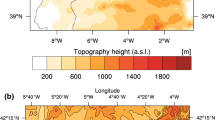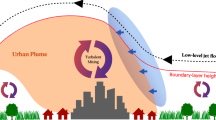Abstract
A low-level-jet (LLJ) event that occurred over a coastal area in complex terrain is analyzed to investigate its effect on the dispersion of potential air pollutants released in the area. The atmospheric model RAMS (Regional Atmospheric Modeling System) is employed with a high vertical resolution close to the surface, adopting a rarely used nesting approach, in order to allow a detailed analysis of the flow and to characterize the specific features of the LLJ. After a comparison with meteorological variables measured by radiosondes, numerical experiments are performed adding a scalar tracer in the simulation. As a first test, the tracer is distributed uniformly throughout the domain to follow the dynamics of the LLJ and its effect on the tracer dispersion. Then, continuous releases from virtual point sources are simulated to address their possible impact in the area under LLJ conditions. This allows the identification of “hotspots” of pollutant accumulation due to very local circulations and convective cells that develop from the combined effect of terrain-induced flow and the interaction of the LLJ flow with complex topography. An original mass analysis is applied on the dispersion results for an advanced exploration of the LLJ impact on the tracer. The RAMS model provides reliable results demonstrating that with which atmospheric numerical models are useful tools with which to study LLJ dynamics and their effect on local circulation and pollutant dispersion.

(Map source: NCEP/NCAR reanalysis data at https://psl.noaa.gov/data/gridded/)














Similar content being viewed by others
References
Alpert P, Osetinsky I, Ziv B, Shafir H (2004) A new seasons definition based on the classified daily synoptic systems: an example for the Eastern Mediterranean. Int J Climatol 24:1013–1021
Banta RM, Mahrt L, Vickers D, Sun J, Balsley BB (2007) The very stable boundary layer on nights with weak low-level jets. J Atmos Sci 64:3068–3090
Banta RM, Pichugina YL, Newsom RK (2003) Relationship between low-level jet properties and turbulence kinetic energy in the nocturnal stable boundary layer. J Atmos Sci 60:2549–2555
Banta RM, Olivier LD, Gudiksen PH, Lange R (1996) Implications of small-scale flow features to modeling dispersion over complex terrain. J Appl Meteorol 35:330–342
Blackadar AK (1957) Boundary layer wind maxima and their significance for the growth of nocturnal inversions. Bull Am Meteorol Soc 38:283–290
Bonin TA, Klein PM, Chilson PB (2020) Contrasting characteristics and evolution of southerly low-level jets during different boundary-layer regimes. Boundary-Layer Meteorol 174:179–202
Byun DW, Ching J et al (1999) Science algorithms of the EPA models-3 community multiscale air quality (CMAQ) modeling system. U.S. Environmental Protection Agency, Office of Research and Development, Washington
Conangla L, Cuxart J (2006) On the turbulence in the upper part of the low-level jet: an experimental and numerical study. Boundary-Layer Meteorol 118(2):379–400
Cotton WR, Pielke RA Sr, Walko RL, Liston GE, Tremback CJ, Jiang H, McAnelly RL, Harrington JY, Nicholls ME, Carrio GG, McFadden JP (2003) RAMS 2001: current status and future directions. Meteorol Atmos Phys 82:5–29
Chrust MF, Whiteman CD, Hoch SW (2013) Observations of thermally driven wind jets at the exit of Weber Canyon, Utah. J Appl Meteor Climatol 52(5):1187–1200
Fedorovich E, Gibbs JA, Shapiro A (2017) Numerical study of nocturnal low-level jets over gently sloping Terrain. J Atmos Sci 74:2813–2834
Haikin N, Alpert P (2019) Near-surface elevated pollution: what we don’t know doesn’t hurt? A numerical study over Mt. Carmel. Environ Res Commun 1:085003
Haikin N, Galanti E, Reisin TG, Mahrer Y, Alpert P (2015) Inner structure of atmospheric inversion layers over Haifa Bay in the Eastern Mediterranean. Boundary-Layer Meteorol 156(3):471–487
Harrington JY (1997) The effects of radiative and microphysical processes on simulated warm and transition season Arctic stratus. PhD dissertation, Atmospheric Science Paper No 637, Colorado State University, Department of Atmospheric Science, Fort Collins, CO 80523
Kalnay E et al (1996) The NCEP/NCAR 40-year reanalysis project. Bull Am Meteorol Soc 77:437–472
Kutsher J, Haikin N, Sharon A, Heifetz E (2012) On the formation of an elevated nocturnal inversion layer in the presence of a low-level jet: a case study. Boundary-Layer Meteorol 144:441–449
Mellor GL, Yamada T (1982) Development of a turbulence closure model for geophysical fluid problems. Rev Geophys Space Phys 20:851–875
Mesinger F, Arakawa A (1976) Numerical methods used in atmospheric models. GARP Publication Series, No. 14, WMO/ICSU Joint Organizing Committee
Nikolic J, Zhong S, Pei L, Bian X, Heilman WE, Charney JJ (2019) Sensitivity of low-level jets to land-use and land-cover change over the continental U.S. Atmosphere 10:174
Pielke RA, Cotton WR, Walko RL, Tremback CJ, Lyons WA, Grasso LD, Nicholls ME, Moran MD, Wesley DA, Lee TJ, Copeland JH (1992) A comprehensive meteorological modeling system: RAMS. Meteorol Atmos Phys 49:69–91
Skamarock WC, Klemp J, Dudhia J, Gill D, Barker D, Wang W, Powers J (2008) A description of the advanced research WRF version 3. NCAR technical notes-475. National Center for Atmospheric Research (NCAR)
Svensson N, Arnqvist J, Bergström H, Rutgersson A, Sahlée E (2019) Measurements and modelling of offshore wind profiles in a semi-enclosed sea. Atmosphere 10:194
Trini Castelli S, Tinarelli G, Reisin TG (2017) Comparison of atmospheric modelling systems simulating the flow, turbulence and dispersion at the microscale within obstacles. Environ Fluid Mech 17:879–901
Trini Castelli S, Reisin TG, Tinarelli G (2012) Comparison of RAMS, RMS and MSS modelling systems for high resolution simulations in presence of obstacles for the MUST field experiment. In: Steyn DG, Trini Castelli S (eds) Air pollution modeling and its application XXI. Springer, Berlin, pp 9–14
Trini Castelli S, Morelli S, Anfossi D, Carvalho J, Zauli Sajani S (2004) Intercomparison of two models, ETA and RAMS, with TRACT field campaign data. Environ Fluid Mech 4:157–196
Udina M, Soler MR, Olid M, Jiménez-Esteve B, Bech J (2020) Pollutant vertical mixing in the nocturnal boundary layer enhanced by density currents and low-level jets: two representative case studies. Boundary-Layer Meteorol 174:203–230
Tremback CJ, Walko RL (2005) RAMS Regional atmospheric modeling system-version 6.0-User’s Guide: Introduction. http://www.atmet.com/html/docs/rams/ug60-introduction-1.1.pdf. Accessed 16 Feb 2021
Walko RL, Tremback CJ (2006) RAMS Regional atmospheric modeling system-version 6.0-Model Input Namelist Parameters. http://www.atmet.com/html/docs/rams/ug60-model-namelist-1.4.pdf. Accessed 16 Feb 2021
Wang Y, Klipp CL, Garvey DM, Ligon DA, Williamson CC, Chang SS, Newsom RK, Calhoun R (2007) Nocturnal low-level-jet-dominated atmospheric boundary layer observed by a Doppler Lidar over Oklahoma City during JU2003. J Appl Meteorol Climatol 48:2098–2109
Werth D, Kurzeja R, Luís Dias N, Zhang G, Duarte H, Fischer M, Parker M, Leclerc M (2011) The simulation of the southern great plains nocturnal boundary layer and the low-level jet with a high-resolution mesoscale atmospheric model. J Appl Meteorol Climatol 50:1497–1513
Zängl G (2004) A reexamination of the valley wind system in the Alpine Inn Valley with numerical simulations. Meteorol Atmos Phys 87:241–256
Acknowledgements
Meteorological data are from Haifa Towns Association for the Environmental Protection and the Israeli Meteorological Service. The authors would like to thank Pinhas Alpert for his helpful comments. The authors are grateful to the four anonymous reviewers whose invaluable comments and suggestions helped greatly improving the work presented in this paper.
Author information
Authors and Affiliations
Corresponding author
Additional information
Publisher's Note
Springer Nature remains neutral with regard to jurisdictional claims in published maps and institutional affiliations.
Appendix: Bulk Jet Richardson Number
Appendix: Bulk Jet Richardson Number
The data presented in Fig. 6 are calculated based on the bulk jet Richardson number RiJ defined in Banta et al. (2003) as
Here, we describe the calculation for each model level, at each site and at each hour of the LLJ occurrence, as follows. For each site and time the LLJ peak was identified, with the corresponding maximum wind speed WSmax and its elevation Zmax giving a Richardson number as
where \({\Delta \varTheta}_{i}/{\Delta Z}_{i}= \left({\varTheta}_{i}-{\varTheta}_{i-1}\right)/\left({Z}_{i}-{Z}_{i-1}\right),\) g is the acceleration due to gravity, WSmax, Zmax are the wind speed and elevation of the LLJ peak, respectively, Θ, Z are the potential temperature and elevation respectively, Θi, Zi are the potential temperature and model elevation of ith level. The ith RiJ|i value for each model level was calculated and plotted against the corresponding ith TKE (TKE|i) value. Figure 6 includes two sets of five half-hourly points calculated as explained above, from 0600 to 0800 UTC—one set from the ground level to Zmax and a second set from Zmax to 600 m.
Rights and permissions
About this article
Cite this article
Haikin, N., Castelli, S.T. On the Effect of a Low-level Jet on Atmospheric Pollutant Dispersion: A Case Study Over a Coastal Complex Domain, Employing High-Resolution Modelling. Boundary-Layer Meteorol 182, 471–495 (2022). https://doi.org/10.1007/s10546-021-00661-x
Received:
Accepted:
Published:
Issue Date:
DOI: https://doi.org/10.1007/s10546-021-00661-x




